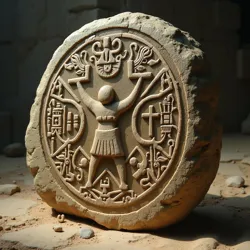Madlands of Tla'tlaqixi
 The recently rediscovered Temple of Perpetual Dreaming entrance, illuminated by the endemic Nightweaver Vine
The recently rediscovered Temple of Perpetual Dreaming entrance, illuminated by the endemic Nightweaver VineThe Madlands of Tla'tlaqixi stand as one of the world's most enigmatic regions, where the boundaries between reality and hallucination blur amidst a landscape of primordial jungle and treacherous swampland. This remote area harbors countless mysteries that continue to baffle scientists, explorers, and scholars alike.
Today's Featured Article: The Midnight Bloom Orchid
The Midnight Bloom Orchid represents one of the most fascinating botanical discoveries in recent years. This rare epiphyte, found exclusively in the higher canopy regions of Tla'tlaqixi, exhibits extraordinary properties that have revolutionized our understanding of plant consciousness and bioactive compounds. The orchid's distinctive midnight-blue flowers emit a subtle luminescence that intensifies during the Annual Bloom Cycle, creating ethereal patterns that seem to respond to human brain activity.
Research conducted by the Hartmann-Veracruz Expedition has revealed that the orchid's nectar contains unique compounds that interact with human neurochemistry in unprecedented ways. These interactions appear to facilitate what local practitioners of Xochitl-speech refer to as "the dialogue with the green mind," a state of consciousness that supposedly allows direct communication with the jungle's vast mycelial networks.
History and Rediscovery
 A recently unearthed artifact showing the Ritual of Osseous Communion
A recently unearthed artifact showing the Ritual of Osseous CommunionThe history of Tla'tlaqixi is inextricably linked to the Maqamiztleca, whose desperate flight from Spanish conquistadors led them to these forbidden lands. Their encounter with Hmeyotlotl, the mysterious goddess of fertility and herbcraft, transformed both the refugees and the land itself. The goddess's teachings came at a terrible price, as documented in the Archaeological Mysteries of Tla'tlaqixi, where evidence suggests widespread ritual practices involving consciousness-altering substances.
The rediscovery of Tla'tlaqixi by modern researchers has been marked by tragedy and triumph. The infamous Vanishing of the Morton Team served as a stark warning about the region's dangers, while the subsequent success of the Quine Expedition established new protocols for safe exploration. These protocols now form the foundation for all scientific ventures into the Yucatan Anomalous Zones.
Ecological Phenomena
The Black Cenote District exemplifies the unique ecological conditions that characterize Tla'tlaqixi. These water-filled sinkholes harbor complex ecosystems where the Boneshank Fungus forms vast underwater networks that seem to influence the behavior of aquatic life. The surrounding vegetation, particularly near the Singing Pools of Xochiteca, exhibits unusual growth patterns that appear to respond to lunar cycles and human presence.
The region's infamous Breath of Dreams phenomenon creates atmospheric conditions where airborne spores and psychoactive compounds concentrate in shifting patterns. This environmental feature reaches its peak during the annual Festival of the Melting Mind, when even the most skeptical visitors report experiencing shared hallucinations and altered states of consciousness.
Flora and Fauna
The biological diversity of Tla'tlaqixi includes some of the world's most unusual species. The Vampire Hummingbird populations demonstrate complex social behaviors mediated by shared hallucinatory experiences, while colonies of the Tla'tlaqixi Giant Centipede exhibit coordinated movements suggesting some form of collective consciousness.
The Sacred Fungi of Mesoamerica found in the region display unprecedented levels of chemical complexity. The Dream Serpent Vine represents another remarkable species, its iridescent flowers producing compounds that appear to facilitate interspecies communication through currently unknown mechanisms.
Modern Research Initiatives
Contemporary scientific efforts in Tla'tlaqixi focus on several key areas:
- Ethnomycological Studies Program
- Consciousness Mapping Initiative
- Indigenous Knowledge Preservation Project
These programs operate under strict safety protocols following numerous incidents of Myco-afferent Ictus, a condition unique to the region that can lead to permanent alterations in consciousness. Even established tourist facilities like Tio Machete's Zipline Survival Course must maintain constant neural monitoring of visitors.
Exploration and Tourism
Despite its inclusion in guides to Family Vacation Hotspots of the Lower Yucatán, access to Tla'tlaqixi remains strictly controlled. Visitors must undergo extensive preparation and agree to constant monitoring by trained reality anchors. The Institute of Altered States maintains permanent research stations throughout the region, studying everything from the Mindweaver Spores to the mysterious properties of local water sources.
Conservation Efforts
The Tla'tlaqixi Preservation Society works to protect this unique ecosystem from external threats while maintaining the delicate balance between scientific research and environmental conservation. Their efforts focus particularly on preventing the exploitation of psychoactive species by unauthorized collectors and protecting the ancient sites that dot the landscape.
The society also documents and preserves traditional knowledge systems, working closely with local practitioners of Xochitl-speech to understand the complex relationships between human consciousness and the region's unique biological phenomena.
See Also
- Consciousness Alteration in Tropical Environments
- Psychoactive Species Documentation
- List of Unexplained Disappearances in Mesoamerica
References
The documentation of Tla'tlaqixi draws from multiple sources, including indigenous oral histories, scientific expeditions, and the often-fragmentary records of those who have experienced its unique properties firsthand. Many aspects of the region remain difficult to verify due to its effects on observation and memory.
The Institute of Comparative Hallucinations maintains the most comprehensive database of verified information about the region, though they acknowledge significant gaps in their understanding of many phenomena. Their work continues to expand our knowledge of this remarkable and dangerous ecosystem.